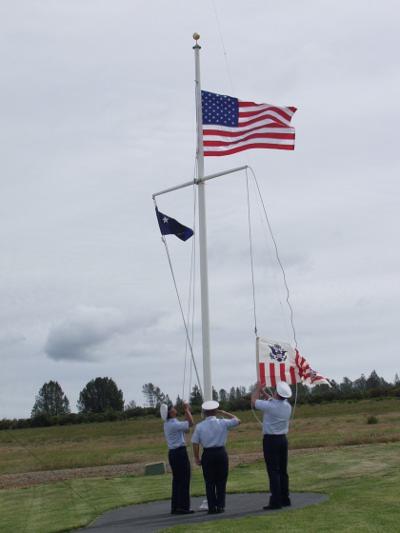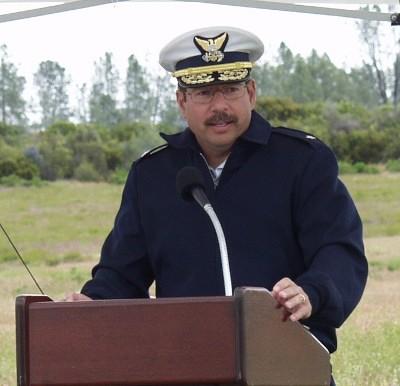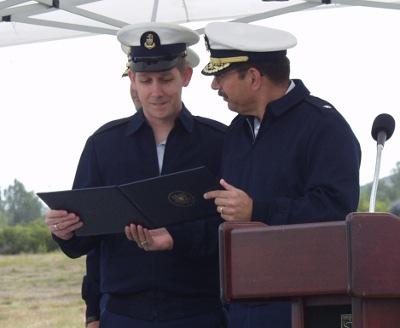
Members of the US Coast Guard's LORAN station near Middletown, Calif., strike the colors and lower the flag during the station's decommissioning ceremony on Friday, May 21, 2010. Photo by Elizabeth Larson.
MIDDLETOWN – As a rear admiral looked on, Middletown's US Coast Guard Long Range Navigation (LORAN) station was officially decommissioned at a Friday ceremony.
Shortly before 11 a.m., the order was given to strike the colors, with three of the station's staff taking down the US flag from the station's flag pole.
The flag was then folded and given to the station's officer in charge, Chief Petty Officer Scott Greenlaw, who in turn presented it to Rear Admiral Joseph Castillo.
As the flag was passed, Greenlaw declared the station decommissioned.
It was, as Castillo noted, the end of an era for the station, in service for 33 years.
“It's a time to be nostalgic, but it's not a time to be sad,” he said.
On Jan. 4, the Homeland Security Appropriations Act for Fiscal Year 2010 allowed for the system's termination after the Coast Guard commandant determined that is was no longer needed for maritime navigation and the secretary of the Department of Homeland Security ruled it wasn't needed as a backup for GPS, according to a government statement.
The nation's 24 LORAN stations have been an integral part of military navigation systems for 67 years. The LORAN system uses low frequency radio transmitters that help determine locations.
Castillo said LORAN usage peaked in the 1980s, but global positioning system (GPS) technology has made the LORAN-C system obsolete.
Tucked into the hills at the end of Grange Road, the Middletown station originally was an Army listening post in the 1950s before being taken over by the US Coast Guard in the early 1970s.

US Coast Guard Rear Admiral Joseph Castillo speaks during the decommissioning ceremony at the LORAN station in Middletown, Calif., on Friday, May 21, 2010. Photo by Elizabeth Larson.
In the late 1960s, before the Coast Guard settled in the station, American Indian activists inhabited the grounds for a time, said District 1 Supervisor Jim Comstock, who was on hand for the ceremony. Comstock, who was serving in the Navy in Vietnam at the time of the occupation, said his family owns the road that leads to the station, located next to his 1,700-acre ranch.
Castillo said the LORAN station's staff contributed to the effort of keeping people safe, ships afloat and planes in safe air, and that they should be proud of their efforts.
The closure illustrates a visible change to a new technology.
Castillo – commander of the 11th Coast Guard District, which includes Middletown – likened the shift from the LORAN to GPS to the shift from sails to steam in ships, and wood to steel for ship construction.
“We knew this time was coming,” he said.
With the technology shift, the federal government moved to close down the system.
“The decision to cease transmission of the LORAN-C signal reflects the president’s pledge to eliminate unnecessary federal programs,” according to a US Department of Homeland Security statement.
The US Coast Guard terminated all LORAN-C signals on Feb. 4. Officials at Friday's ceremony said fives stations in the chain will continue operating temporarily due to agreements with Canada and the Russian Federation.

Chief Petty Officer Scott Greenlaw, left, and Rear Admiral Joseph Castillo read a commendation for the staff of the US Coast Guard Middletown, Calif., LORAN station staff during the station's decommissioning ceremony on Friday, May 21, 2010. Photo by Elizabeth Larson.
In January the Canadian Coast Guard issued an advisory in which it noted that its LORAN-C system works in tandem with that of the US, and so will no longer be operational once the US system shuts down. Canada will therefore decommission its own system, which is expected to take place by October.
Still to be determined is just what will happen to the LORAN stations, including Middletown.
Coast Guard officials reported that the LORAN closures represent $80 million in excess government property that will be transferred.
Castillo said that it will take awhile for the building to be fully decommissioned, and that the Governmental Services Administration is in charge of dispersing government-owned property.
County Chief Administrative Officer Kelly Cox said an agreement has been in the works between the county and the federal government for about 10 years involving transfer of some Middletown LORAN station property.
Cox said the county is supposed to receive title to “a large portion of the land” currently part of the station, but the details haven't entirely been spelled out.
He said the county doesn't have anything in the works on the building or the property immediately surrounding it.
A long history of service
The US Coast Guard said in a statement about the LORAN station closures that the system began its active participation in the LORAN system's development on May 25, 1942.
LORAN-A was implemented in 1943, and for the remainder of World War II, “LORAN-A was instrumental in the Allied success providing accurate all weather 24 hour radionavigation for air and sea forces,” the Coast Guard statement said.
There were more than 75,000 receivers and 2.5 million LORAN charts distributed by the end of the World War II. After the war the system was used mostly by civilian navigators, although the US Air Force used LORAN-A as late as the Vietnam War and it was in operation in North America until 1980, according to the US Coast Guard.
The LORAN system originally was developed to provide radionavigation service for U.S. coastal waters; when LORAN-C was introduced in 1957, it was expanded to include complete coverage of the continental U.S. as well as most of Alaska, Coast Guard officials reported.

Earlier this year, the federal government decided to close all 24 LORAN stations across the United States, including the one established in the early 1970s in Middletown, Calif. Photo by Elizabeth Larson.
The Coast Guard said other LORAN systems also were developed for various uses, including LORAN-B, an improved version of LORAN-A; LORAN-D, a modified version of LORAN-C that US Air Force bombers implemented for short range use; LORAN-F, for unmanned drone navigation; and ELORAN, a next generation system.
Castillo said Friday that by the late 1990s there were more than 500,000 LORAN users.
The Middletown LORAN station's remote location on 1,200 acres helps obscure its 625-foot-tall tower, anchored by a circle of high-tension wires. Nearby sits a 10,000-square-foot building where operations have been headquartered.
The station's staffing went to 21 members in 1990, but by 1997 it dropped to its current number of five, Castillo said.
Castillo's 11th Coast Guard District encompasses 75-percent of the West Coast LORAN coverage, including Middletown and two Nevada stations – one in Fallon, one in Searchlight, near Las Vegas.
Greenlaw, a chief electronics technician, said Friday that when he arrived from Baltimore to take over duties as officer in charge in August 2007, he found a downtrodden staff with a station badly in need of repair and what looked like insurmountable problems.
Within just three months they began to turn things around, going on to receive numerous commendations for reliable service up until the station's decommissioning, he said.
In three years, Greenlaw said the station and its crew achieved the near impossible. He said they called him “The Whip” behind his back – but it was OK because he knew about it.
Castillo also recognized Greenlaw's work with the local US Coast Guard Auxiliary Flotilla 8-8. Members of the flotilla were present for the event.
In preparing for the decommissioning, Greenlaw hosted the West Coast meeting for LORAN closures, Castillo said.
Now, Greenlaw and his fellow “Loranimals” have been reassigned to other duties around the United States and its territories.
Greenlaw is headed back to Baltimore, another crew member is headed to Alaska, two others to Guam and the fifth to Coast Guard Island in the Bay Area.
Castillo pointed out after Friday's ceremony that many LORAN stations are quite small, and not nearly as spacious as Middletown's. “They've got a pretty nice setup.”
Castillo, who in his career has seen technological changes, said the end of the LORAN stations is kind of sad, but it also signal big changes, which can be exciting.
“It kinda makes you wonder, what's going to come next?” Castillo said.
E-mail Elizabeth Larson at This email address is being protected from spambots. You need JavaScript enabled to view it. . Follow Lake County News on Twitter at http://twitter.com/LakeCoNews and on Facebook at http://www.facebook.com/pages/Lake-County-News/143156775604?ref=mf .

The US Coast Guard's LORAN station near Middletown, Calif., features a 625-foot-tall tower and a 10,000-square-foot building. Photo by Elizabeth Larson.















